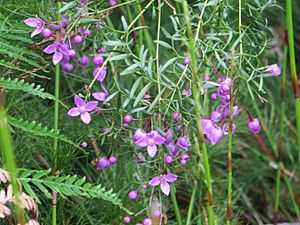Wide Bay boronia facts for kids
Quick facts for kids Wide Bay boronia |
|
|---|---|
 |
|
| Boronia rivularis near Tinnanbar | |
| Scientific classification | |
| Genus: |
Boronia
|
| Species: |
rivularis
|
The Wide Bay boronia, also known as Boronia rivularis, is a special plant that belongs to the citrus family, called Rutaceae. This plant is only found in the Wide Bay–Burnett area, which is in eastern Queensland, Australia. It's a type of shrub that stands tall and woody. It has leaves that look like feathers and pretty flowers that can be white or pink, each with four petals.
Contents
What Does the Wide Bay Boronia Look Like?
The Wide Bay boronia is a woody shrub that grows straight up. It can reach a height of about 2 meters (6.6 feet). Its younger branches are smooth. The leaves of this plant are quite interesting because they are "pinnate." This means they have smaller leaflets arranged along a central stem, like a feather. Each leaf can have between three and thirteen small leaflets.
Leaves and Flowers
The whole leaf, including its stalk, is usually between 17 and 68 millimeters (0.7 to 2.7 inches) long and 15 to 64 millimeters (0.6 to 2.5 inches) wide. The stalk that holds the leaf is about 5 to 15 millimeters (0.2 to 0.6 inches) long. The leaflet at the very end of the leaf is shaped like an ellipse and is about 4 to 32 millimeters (0.2 to 1.3 inches) long and 1 to 5 millimeters (0.04 to 0.2 inches) wide. The leaflets on the sides are similar in size and shape.
The flowers of the Wide Bay boronia grow in groups of three to nine. They can be white or pink. These flower groups appear where the leaves meet the stem, or at the very ends of the branches. Each flower is held on a thin stalk that is about 5 to 17 millimeters (0.2 to 0.7 inches) long.
Flower Parts
Each flower has four small, triangular parts called sepals, which are less than 1 millimeter (0.04 inches) long and wide. It also has four petals, which are the colorful parts of the flower, measuring about 5 to 8 millimeters (0.2 to 0.3 inches) long. Inside the flower, there are eight stamens, which are the parts that produce pollen. These stamens have tiny hairs on their edges.
When Does it Flower and Produce Fruit?
The Wide Bay boronia usually blooms from September to December. After the flowers, the plant produces small fruits. These fruits are about 3 to 4.5 millimeters (0.1 to 0.2 inches) long and 2 to 2.5 millimeters (0.08 to 0.1 inches) wide.
How Was Wide Bay Boronia Named?
The Wide Bay boronia was first officially described in 1942 by a scientist named Cyril Tenison White. He published his description in a scientific paper called Proceedings of the Royal Society of Queensland. The second part of its scientific name, rivularis, comes from a Latin word that means "of a brook." This name was chosen because the plant was found growing in wet, damp areas like gullies, which are small valleys or ravines.
Where Does Wide Bay Boronia Live?
The Wide Bay boronia likes to grow in moist and swampy places. You can find it in areas with heath (low-growing shrubs), woodlands, or open forests. It is found on Fraser Island and in the Cooloola area, both in Queensland.
Is Wide Bay Boronia Protected?
Yes, the Wide Bay boronia is considered "near threatened" by the Queensland Government. This means that while it's not in immediate danger, its population could become threatened if its habitat is not protected. This classification is under the Nature Conservation Act 1992, which helps protect plants and animals in Queensland.

